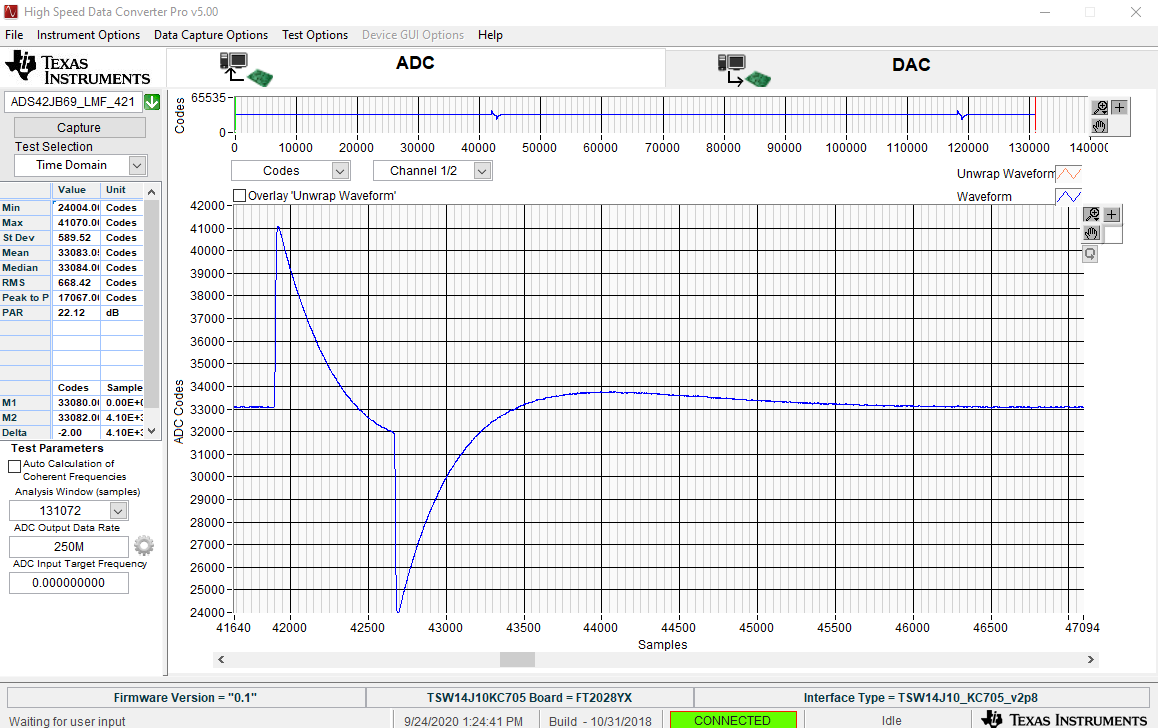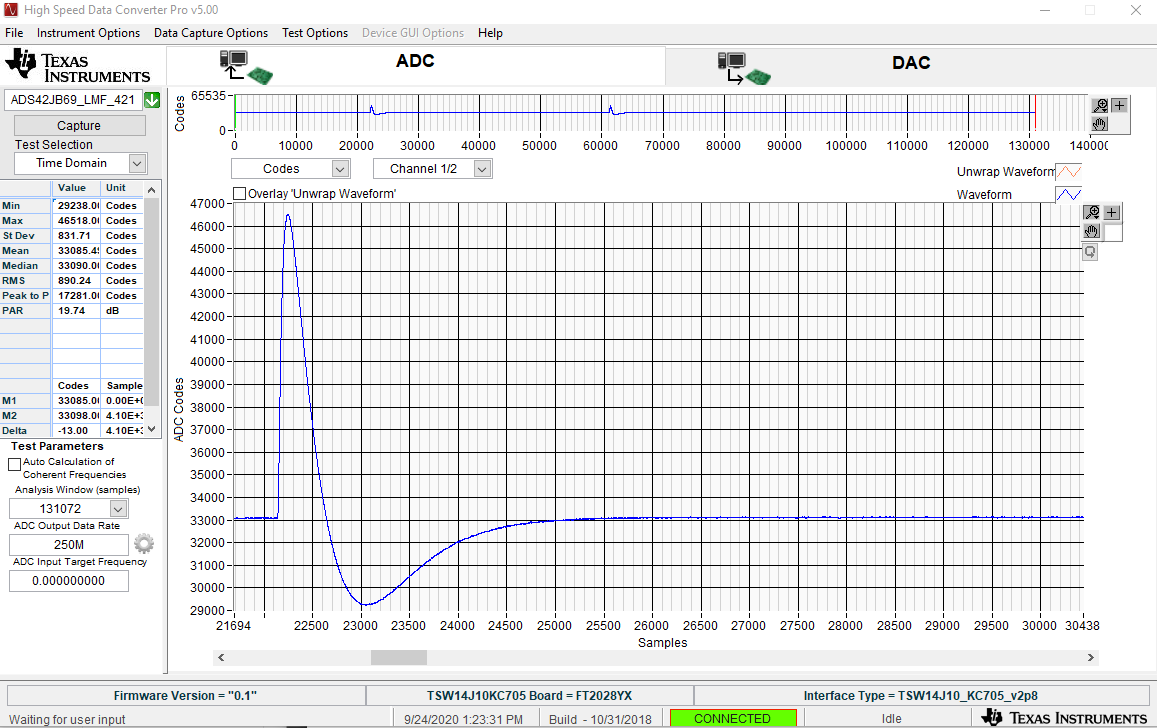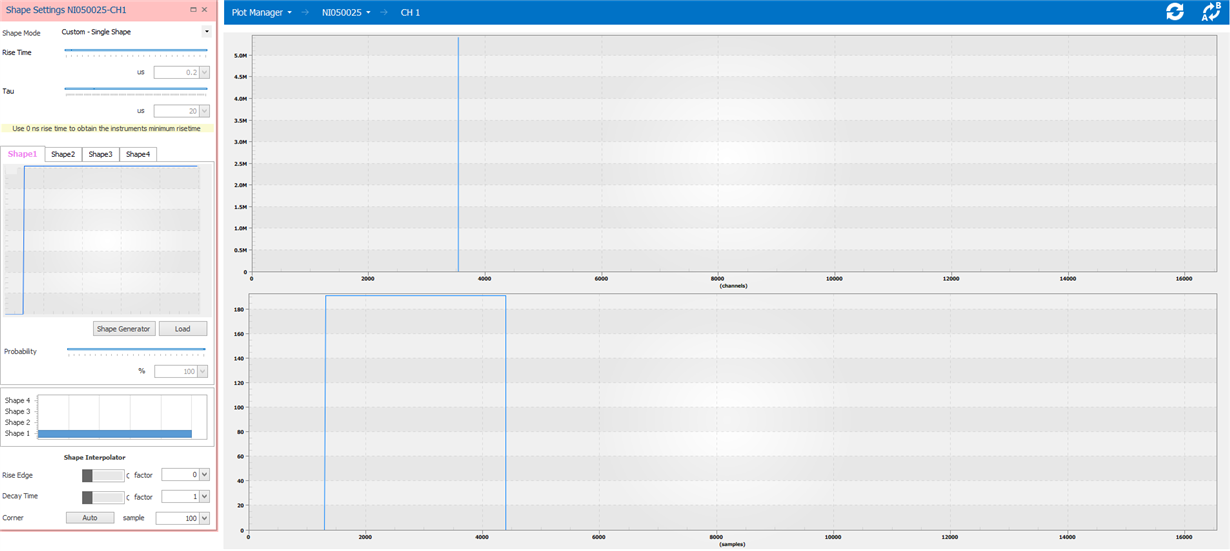Howdy,
I've recently inherited an ADS42JB69EVM board in our lab group and I'm experiencing an issue when attempting to digitize incoming information from an emulator. The emulator is a CAEN DT5810D providing information via a BNC cable with an adapter to the SMA fitting on the EVM board. Ultimately, the goal is to digitize tail pulses coming out of a preamplifier hooked to a radiation detector, then pass them through a TSWTSW14J10 to a KC705.
Whenever I try to digitize a tail pulse, the resulting signal exhibits bipolar characteristics (see below). I have tried inserting a 50-ohm BNC terminator on a T-junction with the input signal and the BNC-to-SMA adaptor in case it was an impedance problem, but that simply reduces the magnitude of the signal and does not change the shape. The configuration file should also be found below.
I've included examples of the source pulse and the resulting digitization seen through HSDC Pro below; any guidance you can provide as to what might be going wrong would be appreciated.
Digitization of tail pulse with tau_rise = 200ns, tau_decay = 20us:
Digitization of rectangular pulse with width = 20us
Configuration File
LMK04828 0x00 0x10 0x02 0x00 0x100 0x0C 0x101 0x55 0x103 0x00 0x104 0x20 0x105 0x00 0x106 0x70 0x107 0x11 0x108 0x6C 0x109 0x55 0x10B 0x00 0x10C 0x20 0x10D 0x00 0x10E 0x71 0x10F 0x66 0x110 0x00 0x111 0x00 0x113 0x00 0x114 0x00 0x115 0x00 0x116 0x08 0x117 0x00 0x118 0x6C 0x119 0x55 0x11B 0x00 0x11C 0x20 0x11D 0x00 0x11E 0x78 0x11F 0x61 0x120 0x0C 0x121 0x55 0x123 0x00 0x124 0x00 0x125 0x00 0x126 0x71 0x127 0x01 0x128 0x00 0x129 0x00 0x12B 0x00 0x12C 0x00 0x12D 0x00 0x12E 0x08 0x12F 0x66 0x130 0x0C 0x131 0x00 0x133 0x00 0x134 0x00 0x135 0x00 0x136 0x08 0x137 0x00 0x138 0x24 0x139 0x03 0x13A 0x01 0x13B 0xE0 0x13C 0x00 0x13D 0x08 0x13E 0x00 0x13F 0x00 0x140 0x00 0x141 0x00 0x142 0x00 0x143 0x31 0x144 0xFF 0x145 0x00 0x146 0x18 0x147 0x1A 0x148 0x10 0x149 0x54 0x14A 0x33 0x14B 0x16 0x14C 0x00 0x14D 0x00 0x14E 0x00 0x14F 0x7F 0x150 0x03 0x151 0x02 0x152 0x00 0x153 0x00 0x154 0x78 0x155 0x00 0x156 0x0A 0x157 0x00 0x158 0x96 0x159 0x00 0x15A 0x64 0x15B 0xD4 0x15C 0x20 0x15D 0x00 0x15E 0x00 0x15F 0x0B 0x160 0x00 0x161 0x01 0x162 0x44 0x163 0x00 0x164 0x00 0x165 0x0F 0x166 0x00 0x167 0x00 0x168 0x0F 0x169 0x59 0x16A 0x20 0x16B 0x00 0x16C 0x00 0x16D 0x00 0x16E 0x13 0x17C 0x15 0x17D 0x0F ADS42JB69 0x06 0x80 0x07 0x00 0x08 0x18 0x0B 0x00 0x0C 0x00 0x0D 0x90 0x0E 0x90 0x0F 0x00 0x10 0x00 0x11 0x00 0x12 0x00 0x13 0x00 0x1F 0x7F 0x26 0x06 0x27 0x03 0x2B 0x00 0x2C 0x00 0x2D 0x13 0x30 0x20 0x36 0x00 0x37 0x00 0x38 0x00 FPGA 0x04 0x00 0x05 0x00 0x0E 0x00 0x0F 0x00




